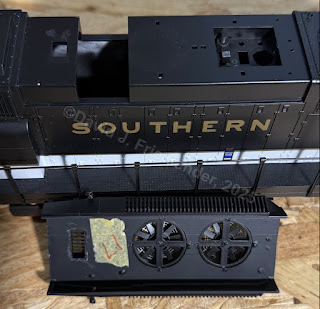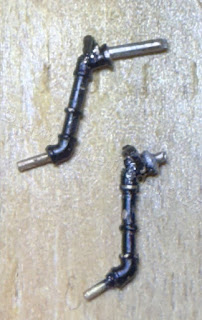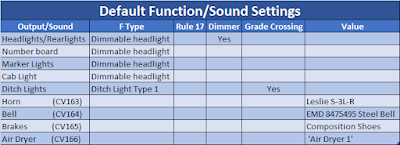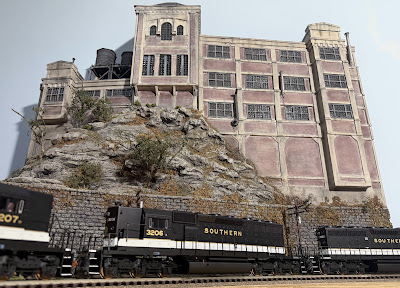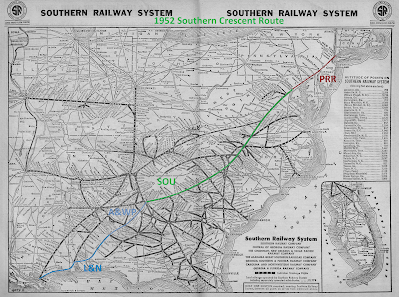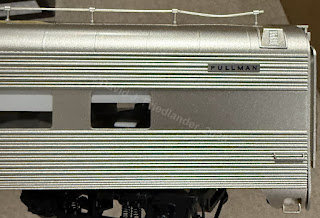My notes tell me this project goes back as far as October 2016. Had it really been that long? My invoice from Sunset Models / Third Rail shows that I paid in February 2024, so yes, it really took nearly 8 years to drum up enough support, design, and produce these models. I'm not in the Sunset Models inner circle, but I did hear this was perhaps the most complex projects that Scott has ever taken on, and the amount of variations maxed his factory's ability to handle high levels of complexity.
Here's an ad for the second run of these locomotives. They run about $800 each.
In any case, here's a little bit more on the SD40-2.
The SD40-2 was the last six-axle EMD product that the Southern bought. Offered by EMD between 1972 and 1986, EMD sold over 4000 units across all roads. It was virtually an SD40, but had more reliable electrical systems, including using removable boards instead of relays. These originally all had turbocharged 16 cylinder 16-645E3 prime movers, capable of putting out 3000HP. General spotting feature differences between the SD40 and SD40'2 include the extra long porches as well as the sight glass on the fireman side of the long hood.
Like any locomotive production, the SD40-2 evolved over its production lifespan, Each notable change became a separate phase. I won't rehash what Trainiax has done an amazing job describing. Sunset Models production is primarily faithful to the initial production phase of 1a1, primarily spotted by the square wire radiator intakes, and separate ECAFB behind the cab.
Southern's fleet of 128 locomotives was numbered 3201-3328. All units lived a second life with Norfolk Southern in 1982, except for locomotive 3217, which wrecked in 1974. Also, as of July 1974, Southern was the last railroad to purchase short high-nose units, as N&W moved to short low hood units. These units were designed to run long-hood forward. A bathroom was located in the short high hood. Sunsets tooling faithfully captures units 3201-3207. The first run contained units 3201, 3203, 3206, and 3207.
Southern's units in the initial run came originally with black handrails, white steps, and gold leaf lettering. Yellow handrails and dulux gold lettering came with later production runs and repaints. Numberboard lettering changed over the years, including with these units straight from the factory. Trust plates were located on the frame at the end of the long hood. Spotting features specific to the SOU included:
- Special MU equipment to let them connect to Locotrol units.
- Long-hood mounted bell.
- A pair of Nathan P-3 horns at both ends of the locomotive body.
- Walkway lights mounted along the paths taken to get into the cab.
- Rectangular cab awnings
I did assist with the CAD and artwork on these. From a CAD perspective, I helped push for the emergency brake chain and correct Jack Pads as well as the emergency fuel stop button and air filter. I helped correct several rivets and lift rings that were missing on the roof. Placement of those along with handrails and some door latches were also an issue on the first round. Specific to Southern, the walkway lights were incorrectly designed and placed. I also pushed for a correctly laid out and facing SOU interior. Three more rounds of review found a few other smaller issues, but also included the Nathan P3 horns being incorrectly designed and the cab vent in the wrong location.
Unfortunately, I was brought in last minute to review the SOU artwork and found just shy of two dozen issues, some of very large magnitude. Examples include incorrect striping and widths both on the carbody and on the pilots; missing carbody text, no trust plate, missing safety striping on the walkway step on the engineering side, incorrect numberboard fonts, incorrect SOUTHERN placement, and incorrect 'F' font and placement. They were able to make those changes very quickly, including a last minute pilot tooling change. The factory executed rather well on these updates.
For those who would like an idea of what 3rd Rail's 2R manuals look like, here are the four pages below:
Post-arrival Review:
Upon arrival, my initial review of these models found only a handful of issues. The project did a very good job being faithful to the prototype and also included some new features that hadn't been done before:
- A more accurate coupler box
- Extended air hoses
- Emergency brake chain under the cab.
- The Southern Cab was assembled correctly.
The shortcomings that I found were as follows:
- The pilot angle isn't quite right and doesn't perfectly line up with the frame shell.
- The air tanks above the fuel tank are not quite the right size and are not placed outward enough.
- Several handrail castings and the air hose casting is too fragile. Perhaps they should have used silver solder.
- The Southern in interior, as usual, was the wrong color. The cab walls were also a little barren.
- The MU casting is incorrect for Southern units.
- The lettering isn't as crisp as on previous projects. Trust plates that are legible in HO are not in O.
- The gold striping is missing on the ECAFB.
- The fuel sight glass configuration is not quite right for Southern.
- The water sight glass wasn't modeled as an actual Window.
- The dynamic brake blister would not sit flush on two of my units. Turned out the castings that were placed through the blister were not filed down flush.
Some of the initial modifications I did were:
- Repainting the interior gray and adding some semblance of panels on the front wall and a door and e brake on the rear wall.
- Filed castings flush on the brake blister as well as drilling holes in the carbody shell to make way for anything that wouldn't sit flush.
- Created a semblance of glass on the water sight glass using Testor's glass maker. I did try AtlasO's parts (MTH SD40-2 parts), but the part was too narrow.
- Drill out the air hoses and solder in long leads to help bend and glue the air hoses to the pilots.
- As these units would be brand new in my modeling era, I painted 'fresh' rust on the couplers and wheel faces.
What's left to do: (Note that the list is much shorter compared to past models)
- Fix the air tanks on locomotives. A gentleman in the UK had designed and 3D printed the right tanks. I hope to leverage his castings.
- Get correct MU castings, perhaps from Gotham Marine.
- Add the gold striping on the ECAFB.
- Reprogram DCC reprogramming to add depth to the locomotive sounds when running them in a consist. That and making it easier to run them as a consist or singularly. Possibly swap out soundsets with other sets.
- Consider making etched legible trust plates.
- Consider adding nano LED's to the walkway lights.
- Consider swapping out the class lights with LED's that would give me Red/White/Green, rather than just White.
Photo Essay of the SOU units in the first run:
Here's a video of one unit in operation:
Here's another one notching the unit up to Notch 8 and back.
Loksound Decoder Addendum:
These come with ESU Loksound L decoders. The L version is limited in how deeply you can customize the functions and sounds. With that said, the manual doesn't do these decoders justice with what one can do with these decoders. For the Southern units, you will at minimum, want to read the CV29 value and write that same value +1 to reverse the 'Forward' Direction of the unit, since factory default has the short hood as the front. That or rewire the motor polarity, but that is easier said than done.
3rd Rail's SD40-2 Manual contains a handful of DCC function mistakes, outlined below:
- F3 is the Rear Marker Light and not the coupler
- F5 only does Front Marker Lights
- F6 lights both front and rear number boards.
It is simplified on purpose, but below is an enhanced version of the function table, based on the default programming:
Default Mapping inside of LokProgrammer
One should also note that the sound file also contains several shortcuts for changing a handful of the sounds and features. The sounds are built into the specific sound project, so if you need something that isn't included, you have to find it in another file, or replace with a non-L version to further customize what you want. We'll start with the how to change and horn and bell.
For Southern, the only sound you'll need to change out of the box is CV163 to 12 for the Nathan P-3 horns. Everything else should be already correctly set.
Horn and Bell Selection:
2nd Gen Horn Pack 1 Horns (SoundCV9):
- CV163=0 Leslie S-3K-R
- CV163=1 Leslie S-3L-R
- CV163=2 Leslie S-5T-F
- CV163=3 Leslie S-5T-R
- CV163=4 Nathan K-3H
- CV163=5 Nathan K-3L
- CV163=6 Nathan K-3LA
- CV163=7 Nathan K-5H
- CV163=8 Nathan K-5LA
- CV163=9 Nathan K-5LA-R24
- CV163=10 Nathan M-3
- CV163=11 Nathan M-3H
- CV163=12 Nathan P-3
- CV163=13 Nathan P-5-R24
EMD 2nd Generation Bell Template Pack 1 Bells (SoundCV10):
- CV164=0 EMD 8475495 Steel Bell 003
- CV164=1 EMD 8004156 Bronze Bell 003
- CV164=2 UKM B443 Steel Bell 001
- CV164=3 Graham-White E-Bell 004
- CV164=4 Transtronic E-Bell 001
- CV164=5 WC Hayes 0333 M-Bell 001
Brake / Air Dryer Sounds:
2nd Generation Brake Squeal Template Pack 1 Brake Squeal (SoundCV11)
- CV165=0 Composition Shoe
- CV165=1 Cast Iron Shoe
EMD 2nd Generation Air Dryer Template Pack 1 Air Dryer (SoundCV12)
- CV166=0 SD40-2 Air Dryer 1
- CV166=1 SD40-2 Air Dryer 2
- CV166=2 SD40-2 Air Dryer 3
- CV166=3 SD40-2 Air Dryer 4
Primer Mover Sound Features:
This project is a reverser based low idle version. It has a single turbo early exhaust stack.
File also contains a "low Idle" Mode on F15 when Standing Still.
Pressing
F15 while not moving will lower the prime mover and lock the motor. F15
must be turned off to go to "regular idle" and begin moving.
Another
"low Idle" Mode is reverser in center position. When pressing F24 while
stopped, you can throttle through the notches like the prototype in
neutral. F24 must be turned off to go to "regular idle" and begin
moving.
This project has "Run 8" mode. When turning on F26 with
F28 off, the prime mover goes to run 8. Turning off F26 returns the
prime mover sounds back to normal mode.
This project has "Coast"
mode. When turning on F27 with F28 off, the prime mover goes to idle
for coasting purposes. Turning off F27 returns the prime mover sounds
back to normal mode.
You can still use F26 and F27 for manual
notching. You have to keep both F26 and F27 off before pressing F28 to
turn on manual notching. Once F28 is on, you can use F26 to notch up and
F27 to notch down. F26, F27, and F28 must be turned off to return to
normal mode.
This project has "Load" mode. When turning on F29
with F15, F24, F26, F27, F28 off, the prime mover goes into load mode.
While you are using load mode, the prime mover will notch up 1 or more
notches based on primary load settings(CV104). The throttle notches up
using speed instead of requested speed while using the load feature. F29
must be turned off to return to normal mode.
This file is also
equipped with a Smart Start feature that cycles the prime mover on and
off at intervals of your choice if the throttle is left at Idle and the
loco is stopped.
Smart Start (Sound CV14):
CV168=0 No Smart Start Cycle - Default
CV168=1 - 3 Minute Cycle
CV168=2 - 6 Minute Cycle
CV168=3 - 9 Minute Cycle
CV168=4 - 12 Minute Cycle
Etc.....
CV168=255 - 765 Minute Cycle
Auto Bell:
Many Second and Third Generation locomotives have been fitted with an Automatic Bell that is triggered when the horn is blown. In MANY cases this cannot even be bypassed on modern locos. Before the FRA mandated this feature on new locomotives the bell was of course turned on and off separately. Some locomotives were delivered with a manual bell and have been converted to an automatic bell. This creates a challenge in sound file creation.
We realize that not every loco with a particular prime mover had this feature. As such we have built in an option to turn the feature on and off. We will set the default in the file to be what is most appropriate for the particular file.
To turn the feature OFF - Auto Bell OFF:
1. Remove the Auto bell sound slot from the function mapping chart
CV31 = 16, CV32 = 8
----------------------
CV311 = 4
2. Change the sound configuration of the Auto bell sound slot
CV31 = 16, CV32 = 1
----------------------
CV287 = 0
To turn the feature ON - Auto Bell ON:
1. ADD the Auto bell sound slot from the function mapping chart
CV31 = 16, CV32 = 8
----------------------
CV311 = 12
2. Change the sound configuration of the Auto bell sound slot
CV31 = 16, CV32 = 1
----------------------
CV287 = 1
Auto Bell Timer:
The Bell timer is amount of time the bell will play after the horn if the auto timer is active. The timer is broken down into 1/4 of a second increments.
- CV169=4 - 1 Second
- CV169=8 - 2 Seconds
- CV169=12 - 3 Seconds
- CV169=16 - 4 Seconds
- CV169=20 - 5 Seconds - Default
- Etc...
Additional Loksound Decoder Addendum:
I had run into some issues programming my units using the LokProgrammer on a programming track. Based on feedback from Loksound Support, I will eventually add a supplemental document here that should help those that wish to perform deeper configuration of their decoders.
Thanks for stopping by!





.JPG)


